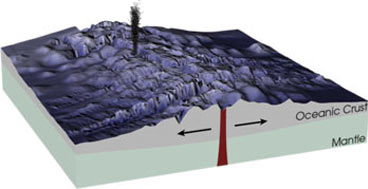You can’t feel it, but the earth beneath your feet is moving. Thin plates of rock -- a combination of the crust and some of the rock in the layer below, the mantle -- glide atop the deeper layers of rock -- a process known as plate tectonics. Scientists have used several techniques to measure this motion.

One way to measure long-term motions is by measuring the magnetism of the rocks on the ocean floor.
New crust is formed at globe-circling volcanic mountain ranges known as mid-ocean ridges. As the plates there move apart, rock pushes up from the mantle to fill the gap, forming new crust. As this material moves outward, it cools and hardens. As it does so, it’s imprinted with Earth’s magnetic field.
The field changes over time. In fact, every few hundred thousand years it flips over -- the north magnetic pole becomes the south pole and vice versa. Each change in the field is recorded in the ocean crust. Measurements reveal matching magnetic “stripes” on either side of the mid-ocean ridges. The rock in the pairs of stripes formed as a single band, then split and spread apart as the plates moved away from each other.
These magnetic stripes show that the motion of the plates is slow -- a finding confirmed by another technique. Precise tracking of GPS satellites in low Earth orbit allows scientists to measure the distances between tracking stations on different continents. As the plates move, so do the tracking stations. They confirm that the plates drift along at a rate of an inch or two per year.

